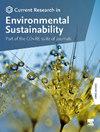Unveiling the hidden patterns of household food waste
IF 3.8
Q2 ENVIRONMENTAL SCIENCES
Current Research in Environmental Sustainability
Pub Date : 2025-01-01
DOI:10.1016/j.crsust.2025.100292
引用次数: 0
Abstract
Among the methods commonly used for quantifying food waste in households, there are limitations that affect the reliability of quantification results. To address these, this study used an automated quantification tool to objectively and with high precision quantify food waste in 28 Swedish households for an extended period, reaching a total of 3945 quantification days. The results showed that the average daily waste amounted to 0.159 kg per person. Recorded food waste displayed a large variation between days, weeks and months, suggesting that long-term quantification is necessary for precision. As the results indicated, between 115 and 569 quantification days is necessary to provide an average estimate with a ± 10 % precision. This study presents empirical evidence demonstrating the feasibility and opportunities of automated food waste quantification, emphasizing the importance of extended measurement periods, high-frequency data collection, and minimal user intervention on designing effective waste tracking systems.

揭露家庭食物浪费的隐藏模式
目前常用的家庭食物浪费量化方法存在局限性,影响了量化结果的可靠性。为了解决这些问题,本研究使用自动化量化工具,对28个瑞典家庭的食物浪费进行了长期客观、高精度的量化,总共达到3945个量化天。结果表明,人均日垃圾量为0.159公斤。记录的食物浪费在几天、几周和几个月之间显示出很大的变化,这表明长期量化是精确的必要条件。结果表明,需要115 ~ 569个定量天才能提供±10%精度的平均估计值。本研究提供了实证证据,证明了自动化食物垃圾量化的可行性和机会,强调了延长测量周期、高频数据收集和最小化用户干预对设计有效的废物跟踪系统的重要性。
本文章由计算机程序翻译,如有差异,请以英文原文为准。
求助全文
约1分钟内获得全文
求助全文
来源期刊

Current Research in Environmental Sustainability
Environmental Science-General Environmental Science
CiteScore
7.50
自引率
9.10%
发文量
76
审稿时长
95 days
 求助内容:
求助内容: 应助结果提醒方式:
应助结果提醒方式:


